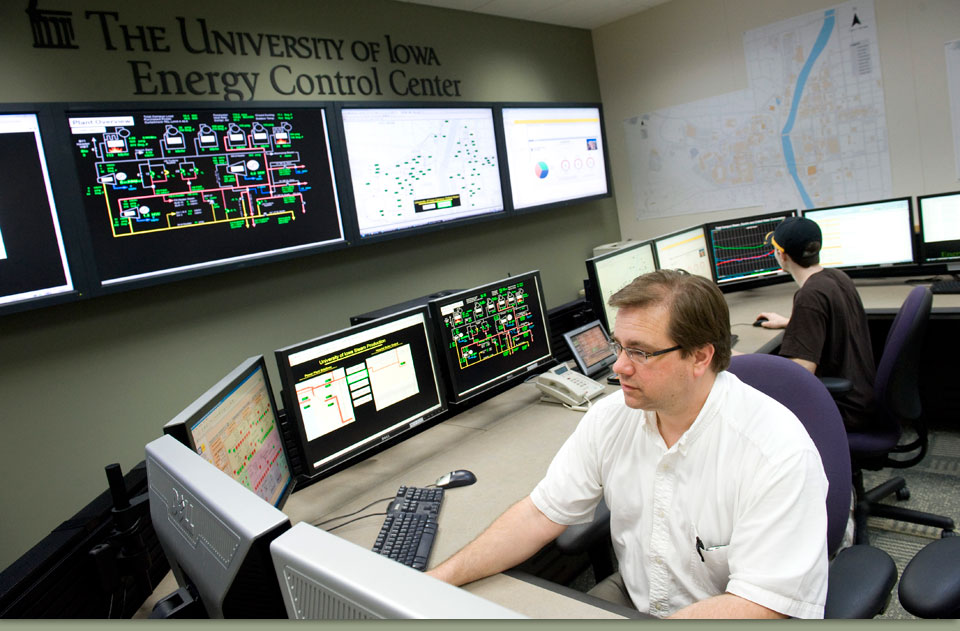-
Page Navigation Links:
- Skip to Site Navigation Links
- Skip to Features

- The University of Iowa
- Spectator
- Monthly News for UI Alumni and Friends

Tucked away behind a nondescript door on the third floor of Iowa’s University Services Building is a scene one might have imagined to be aboard Star Trek’s Enterprise.
The room has four large, flat-screen television monitors mounted side-by-side on a wall above a large, U-shaped desk with another dozen smaller monitors. The screens offer colorful, live displays of information, including schemata of boilers and water chillers with their current operating capacities and a satellite image of the United States showing a looped weather radar.
This is no spaceship flight deck—but it’s equally cool. It’s the University’s new Energy Control Center, and with it comes the power to streamline energy usage and production across some 17 million square feet of the UI campus, the potential to save millions of dollars, and the promise of reducing the University’s carbon footprint.
“With the Energy Control Center, we’re taking energy management to a whole new level,” says Liz Christiansen, director of the UI Office of Sustainability. “We’re driving waste out of the system.”
Here’s how it works: real-time data is collected from more than 100,000 measurement and control points across campus and presented via the Energy Control Center to UI Facilities Management employees. Using software developed for the University by Rockwell Automation, UI engineers can then review and analyze the data and incorporate weather forecasts to decide which chillers, boilers, and turbines to use to power campus 24 hours in advance. They also can use the information to guide the University’s energy purchases and detect problems before they occur.
The center, which will be formally introduced by UI President Sally Mason at a ribbon-cutting ceremony April 23, has been operational since January. In its short life it already has demonstrated its value, says Glen Mowery, director of Utilities & Energy Management. By identifying problems in the University’s steam-distribution systems, it saved the University months of troubleshooting and countless staff hours.
“We were able to pick the problems right off the screen,” Mowery says. “Historically, we have relied on our customers to call us and tell us of a problem, like ‘It’s too hot’ or ‘The air handler is not working.’ Then we’d notify Work Control, generate a job ticket, and send out a mechanic. Depending on priorities, there may have been a delay. Now, we see the problem before the customer is aware of it.”
The energy data had been collected previously, but being able to review it in a single dynamic system better equips Facilities Management staff to focus on the University-wide mission of sustainability, explains Zuhair Mased, associate director of Utilities & Energy Management.
“This system promotes cross-functional teams. Successful energy management programs require collaboration at all levels,” Mased says. “It’s a paradigm shift—we’re changing the mentality of how we do business.”
The Energy Control Center had been in development for several years, but a $483,500 grant appropriated through the American Recovery and Reinvestment Act of 2009 helped accelerate the project. Rockwell Automation now is marketing the system software to other colleges across the country.
“We believe ours is the most advanced, integrated, and comprehensive energy control center in higher education,” Mowery says.
The center is part of an ambitious University goal to significantly reduce energy use overall and increase the percentage of energy derived from renewable energy sources. Currently, the University operates power and water plants along the Iowa River and three chilled water plants to provide steam, water, high-purity water, chilled water, electricity, and sewer services to the entire campus, including the UI Hospitals and Clinics. It also maintains satellite facilities at the Oakdale campus.
In addition to purchasing electricity, natural gas, biomass, and coal to power the campus, UI officials are exploring alternative energy sources such as wood chips, wind, solar, and photovoltaic, and pursuing the revival of a hydroelectric facility at its main power plant. A project that could come to fruition by the end of the calendar year would pipe methane gas from the Iowa City landfill to power the Oakdale campus.
Mowery says he hopes to increase public awareness of campus energy consumption and even spur behavior modification by eventually posting online real-time energy data for all campus buildings.
Establishing the Energy Control Center illustrates the University’s commitment to efficient and environmentally friendly energy use, but it also will enable Iowa to lead in energy education and economic development by providing a learning laboratory, says Barry Butler, dean of the College of Engineering.
“We’ve positioned ourselves as a leader in biomass energy; now we’ve got to bolster the talent,” Butler says. “There is a workforce shortage in the renewable energy industry, and there is expected to be an infusion of private investment that will drive much more development. Students will be able to gain experience in energy design and systems management here at The University of Iowa.”
The public launch of the Energy Control Center, notes Christiansen, is the perfect way to celebrate Earth Month.
“We have the opportunity to continuously improve our sustainability performance, reduce our greenhouse gas emissions and our energy costs, and to lighten our environmental footprint,” she says.
To learn more about campus energy management and sustainability, visit www.facilities.uiowa.edu/uem/energy-management.
—Sara Epstein Moninger
with photo by Kirk Murray
© The University of Iowa 2009
